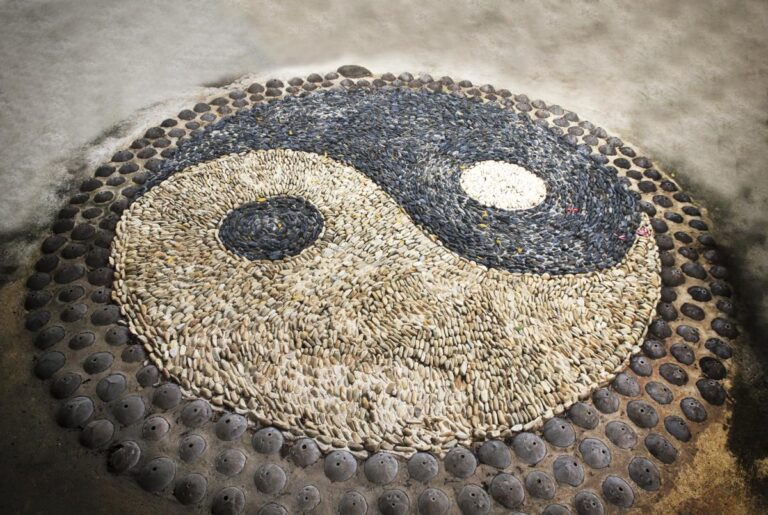Taoist meditation
The main feature of this type of meditation is the generation, transformation and circulation of inner energy. The goal is to calm the body and mind, unite body and mind, find inner peace and come into harmony with the Tao. Some styles of Taoist meditation are specifically aimed at improving health and giving you longevity.
How to do that
There are several types of Taoist meditation, and these are sometimes divided into three categories: ‘insight’, ‘concentrative’ and ‘visualization’. Here’s a quick overview:
- Meditation of emptiness
– sit quietly and get rid of all mental images (thoughts, feelings, etc.), ‘forget everything’, to experience inner peace and emptiness. In this state, vital force and ‘spirit’ are collected and replenished. This is similar to the Confucius discipline of ‘heart-mind fasting’ and is considered ‘the natural way’. You simply allow all thoughts and sensations to arise and disappear on their own, without engaging with them or ‘following’ them. If this is found too difficult and “uninteresting”, the student is taught other forms of meditation, such as visualization and Qigong - Breathing meditation
(Zhuanqi)– to focus on breathing, or “uniting mind and qi”. The instruction is: “concentrate your vital breath until it is extremely soft.” Sometimes this is done by simply quietly observing the breath (similar to mindfulness meditation in Buddhism); in other traditions this is done by following certain patterns of inhaling and exhaling, so that one becomes immediately aware of the ‘dynamics of heaven and earth’ through ascending and descending breathing (a kind of Qigong, comparable to Pranayama in yoga).
- Neiguan
(“inner observation; inner vision”) – visualizing within one’s body and mind, including the organs, “inner gods”, qi (vital force) movements and thought processes. It is a process in which you become acquainted with the wisdom of nature in your body. There are specific instructions for following this exercise, and a good book or teacher is required.
Master Liu Sichuan emphasizes that, although not easy, you should ideally practice “merging the breath and the mind”; for those who find this too difficult, he recommends focusing on the lower abdomen (dantian).
Learn more:
Is it for me?
People who are more connected to the body and nature may want to try Taoist meditation, and enjoy learning about the philosophy behind it. Or if you like martial arts or Tai Chi, this might be of interest to you. However, Taoist centers and teachers are not as easy to find as Buddhist and Yoga centers, so following these can be a challenge.
Qigong (Chi Kung)
Origin & Meaning
Qigong (also spelled chi kung or chi gung) is a Chinese word meaning “life energy cultivation” and is a mind-body exercise for health, meditation and martial arts training. It usually involves slow exercise, inner focus and regulated breathing. Traditionally it was practiced and taught in secret in the Chinese Buddhist, Taoist and Confucian traditions. In the 20th century, the Qigong movement incorporated and popularized Taoist meditation, and “mainly uses concentration exercises, but also promotes the circulation of energy in an inner alchemical way” (Kohn 2008a: 120).
Taoist practices can also make use of Qigong, but since Qigong is also used in other Chinese philosophies, I have decided to treat it as a separate topic.
How to do that
Thousands of different Qigong exercises have been catalogued, involving more than 80 different types of breathing. Some are specific to martial arts (to energize and strengthen the body); others are for health (to nourish bodily functions or cure diseases); and others for meditation and spiritual cultivation. Qigong can be practiced in a static position (sitting or standing), or through a dynamic series of movements – commonly seen in YouTube videos and DVDs. The exercises done as meditation are normally done while sitting and without movement.
To understand more about Qigong and learn how to do it, I recommend reading a book or DVD set by Dr. Yang Jwing Ming to purchase, like this. But here is an introductory overview of the practice of seated Qigong meditation:
- Sit in a comfortable position. Make sure your body is balanced and centered.
- Relax your entire body: muscles, nerves and internal organs
- Regulate your breathing, make it deep, long and soft.
- Calm your mind
- Place all your attention in the “lower dantien”, the center of gravity of the body, two inches below the navel. This will help the qi (vital energy) accumulate and take root. Where your mind and intention are, there your qi will be. So by focusing on the dantien, you collect energy in this natural reservoir.
- Feel the Qi circulating freely through your body.
Other well-known Qigong exercises are:
Minor circulation (also called ‘microcosmic circulation’)
Embryonic respiration
Eight pieces of brocade (see this book excerpt
& Wikipedia article)
Muscle Tendon Change (or “Yi Jin Jing”, given by Bodhidharma)
The first two are sitting meditation, while the last two are dynamic Qigong, which integrates body stretches.
Learn more:
Is it for me?
Qigong meditation may be more appealing to people who would like to incorporate more active body and energy work into the practice. If sitting meditation is unbearable for you and you prefer to be a little more active, try some of the more dynamic forms of Qigong. Again, there are different styles of Qigong available, and you may have to try different teachers or DVDs to find the style that suits you. Some people get a taste of dynamic Qigong through the practice of Tai Chi.

